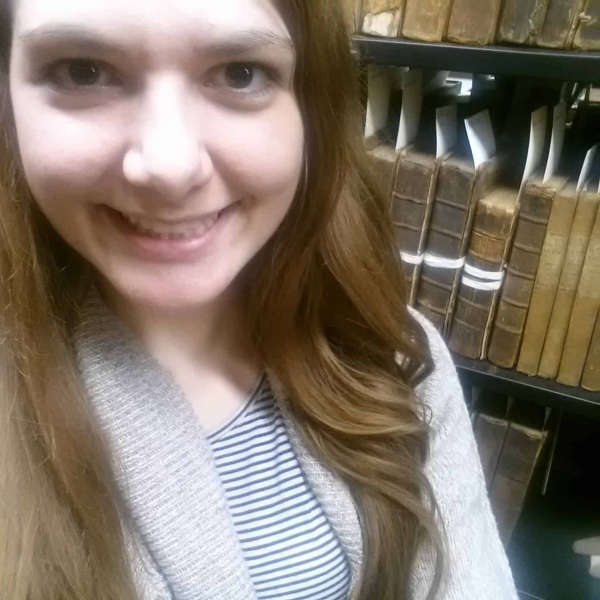The Union Library Company of Hatboro

Kayla Hohenstein in front of Hatboro book collection
The Union Library Company of Hatboro, Pennsylvania, founded in 1755, is one of the oldest public libraries in America and one of many that imitated the Library Company of Philadelphia in name, mission, and organization. Recently the Board of Directors of the Hatboro Library approved a long-term deposit in the Library Company of Philadelphia of some 325 volumes from their collection. Most of them were published before 1800 and they represent some of their earliest acquisitions and their rarest books. None of them is in the Library Company of Philadelphia, and some cannot be found in any American library.
As part of the deposit agreement, we are cataloging these books in WolfPAC, our online catalog, and the cataloger is Kayla Hohenstein, an Earlham College student working on an internship supervised by the Philadelphia Center, which places interns from a score of Midwestern liberal arts colleges with a wide variety of Philadelphia organizations. When Kayla first interviewed with us, she mentioned that as a high school student she had worked as a volunteer at her local public library, in Hatboro, helping to inventory their historic collection. At that time we did not know when or if the deposit would be approved, but by sheer luck it was approved and the books were transferred here just in time for her to complete the project she began four years ago. Here is a blog post that Kayla wrote about her work with the Hatboro Union Library rare books:
In the summer of 2011, at the recommendation of a friend, I applied to work for The Union Library of Hatboro, and went on to assist in cataloging a part of their collection of books and periodicals from the 17th through 19th centuries. Prior to my experience, I was uninformed of The Union Library’s historical significance of being one of the oldest public libraries in the United States, and soon learned of the nature of work that went into caring for and maintaining a fragile and precious collection of this kind.
On my very first day, I was told to come prepared and I remember showing up in my jeans and t-shirt, anticipating the wonder that awaited me. Walking into the library’s main reading room, I looked up at the books that rested on the shelves that lined the walls of the second floor balcony. I had never worked with books this old before and was in awe as I started to carefully handle them as they were cataloged. My job was to assign an accession numbers and to create a flag for each book. This involved documenting the titles, authors, and publication details into an excel spreadsheet, as well as reporting on the bindings and conditions of the books. This experience introduced me to some of the texts on various discourses and treatises from its time, as well as some beautiful printed illustrations such as the ones in Godey’s Lady Book Magazine. Every day, I got to hold pieces of history that revealed some of the thoughts that were seen as important during these lifetimes, and I got to listen to the voices of this culture that were passionate, informative, playful and provoking.
That summer, I got to work alongside more experienced students who taught me about some of the background and history of the texts. They taught me about some of the basic types of leather, cloth, and marble bindings and I soon found myself identifying numerous stamped leather and cloth bound books that I examined. As time passed each day, I came across books with a wide range of conditions and conservational needs. Some of the books had detached covers and split spines, and I soon became accustomed to coming home with book ash on my jeans, which was common with some of the leather bound books. We tied the books up with spools of cloth tape and placed them back on the shelves, and I never thought that I would be seeing these books any further than their home at The Union Library of Hatboro.
After four years of working on my undergrad in the Midwest, I found myself returning home to Philadelphia in the last semester of my senior year and enrolling in an internship program affiliated with my school. Since my time working with The Union Library’s collection, I knew that I wanted to work in a library and learn more about rare books. I decided to apply for a position at The Library Company of Philadelphia for their groundbreaking history as the first American lending library, and soon learned of their correspondence with The Union Library and their agreement to take some of Hatboro’s books on deposit. The symbolic nature of this coincidence brought so much meaning into my life as I assisted in transitioning these books into their new home at The Library Company. Being able to help carry the eighteen boxes of books in and shelve them in their permanent home brought these last four years full circle as I got to see my handwriting on a few of the book tags of books that I had contributed to earlier in my academic career. I feel so fortunate to have had that experience at The Union Library, and to now be able to build on my knowledge and experience here at The Library Company. Since working here, I have been touched by the books and people that I get to work with on a daily basis, and it has inspired me to continue my pursuit in learning more about rare books and in working with these collections.


Leave a Reply
Want to join the discussion?Feel free to contribute!